
Everything You Need To Know About Stevia
Stevia makes for an easy growing experience, and its leaves can be used as a natural sweetener, which may be especially interesting for those who want to maintain a healthy diet and/or have diabetes. Read on to learn about the plant's potential benefits and how to grow it yourself.
You might have heard of this humble herb, and perhaps you've even come to try it. Find out everything you need to know about stevia below, and discover how to easily grow it at home.
What is stevia?
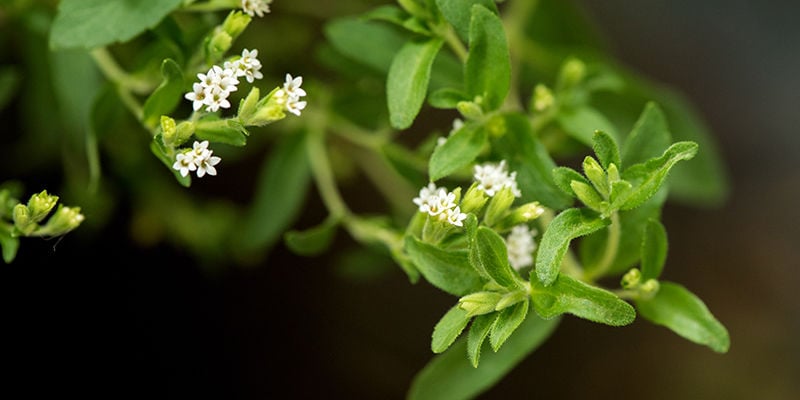
Stevia (Stevia rebaudiana) is a member of the Asteraceae family, to which daisies belong, too. The herbaceous perennial plant is grown as an annual and is popular for its sweet-tasting leaves. The leaves of stevia can be as much as 40 times sweeter than granulated sugar—but contain almost no calories. This makes stevia perfect for those who want to sweeten their foods and drinks but want to avoid sugar and artificial sweeteners. Besides, it has a little bit of a liquorice-like flavour that many enjoy.
Stevia is a compact herb that grows in a clumpy fashion and flowers in late summer. The leaves appear as long, serrated green fingers and the flowers are delicate and white. When growing stevia, it's important to pinch off bud growth when it occurs—because once the plant has flowered, the leaves will have a bitter aftertaste.
For best results, consider allowing stevia to die each autumn and then replant it the next spring.
Where is stevia from?
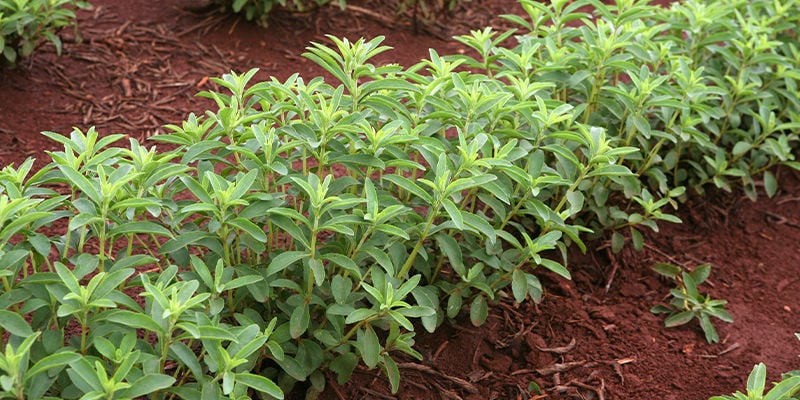
Stevia hails from Brazil and Paraguay, so if you’re growing it in Europe, it’s quite far from home! As you might be able to guess based on its native homes, it likes warm, humid environments.
Stevia has a long history of use and human interest. The Guaraní people have used it as a sweetener for over 1,500 years. And back in 1931, two French chemists isolated the glycosides that are responsible for stevia’s sweet taste.
How to grow stevia
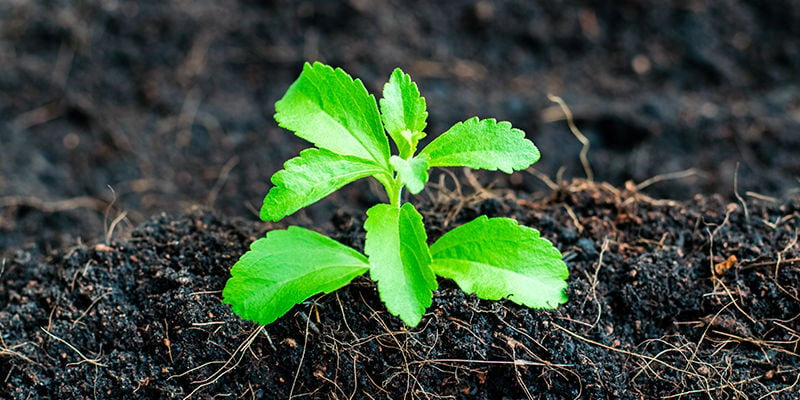
Stevia is known to be a relatively easy plant to grow. On the whole, it likes warmth and sunlight, and can’t handle temperatures below 7°C. But if you can keep it warm and lit, you normally won't struggle to grow it successfully. Generally, stevia is very resistant to pests and disease, meaning it requires little in terms of care.
If you know how to grow basil, then you can grow stevia in much the same way. If not, then read on to find out how to best grow stevia.
1. Choose the right location
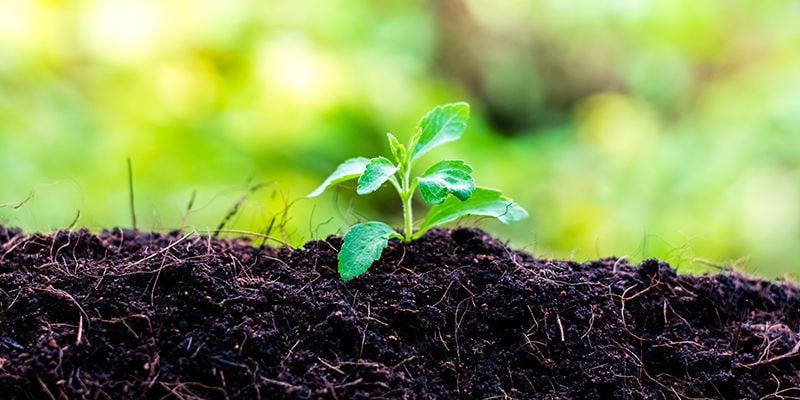
Stevia grows best outdoors, but it can also be grown in pots on sunny windowsills (give them space, though).
In most European locations, stevia will thrive best in direct sunlight. However, if you live somewhere where the summers get very hot and direct sunlight is intense, your stevia plants might prefer growing in partial shade.
2. Prepare the medium
Stevia likes well-drained, loamy soil. Before planting it, add some compost or organic fertiliser to the soil and then turn it, for best results. The ideal soil pH for stevia is 6.7–7.2.
3. Germinate your stevia seeds
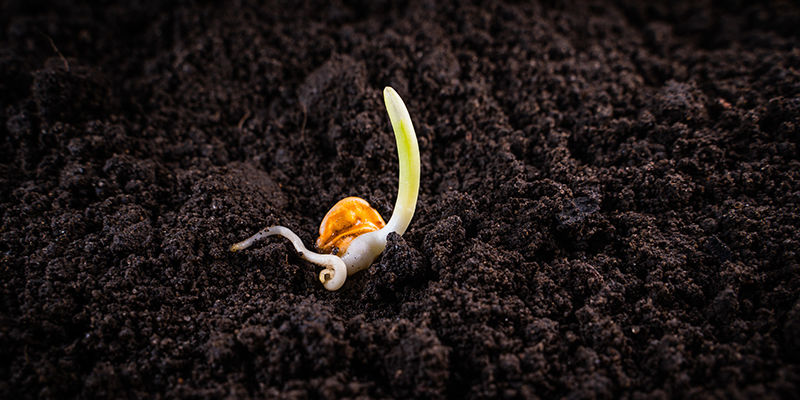
Stevia does not like the cold. Therefore, it should be germinated in warm, post-frost conditions. The ideal germination temperature is 21°C. You can germinate it indoors, then move it outdoors once the seedlings are a little more robust. Do not move stevia outdoors until the weather has warmed a little and the last frost has truly passed. It might be worth hardening the plant(s) off if you move them outdoors, especially if the weather is still a bit cool.
Alternatively, you can sow stevia seeds directly outdoors. If you choose to do this, then you should plant it around two weeks after the last frost. This should ensure that the weather is stable and that you and your little baby don’t get caught out by a sudden cold spell.
Stevia should germinate within 7–21 days.
Stevia seeds should be lightly pressed into the growing medium (not covered). As plants exhibit clumpy growth, plant seeds around 20–30cm apart so they have enough space to develop healthily.
4. Maintain your plants
Once stevia gets going, it’s quite good at taking care of itself, which makes it an easy plant to grow. The main maintenance the plant requires is to pinch off the growth tips to help it grow densely, rather than allowing it to stretch too much.
As mentioned, stevia likes a humid environment, so it prefers soil that remains evenly moist. With some types of plants, you should let the topsoil dry out between watering. But with stevia, this is not the case. It’s best to regularly and lightly water the soil so that there is always moisture available to the plant. If you don’t keep this up, you’ll notice that it wilts incredibly easily.
Also, feed it lightly with organic fertiliser (you don't want any horrible chemicals in your body) once every two weeks or so, starting in early summer (don't overdo it, though).
5. Harvest your stevia plants
Stevia leaves can be harvested continually once the plant is more than 15cm tall. If you want it as sweet as possible, harvest the leaves in the morning, which is when the sugar content is at its highest point. Use scissors or secateurs to snip the leaves off.
Once the flowers open, the leaves will become more bitter and less viable for culinary use. Therefore, you should harvest all of the leaves before the flowers begin to open—so keep this in mind as the end of summer comes near.
How to prepare stevia leaves
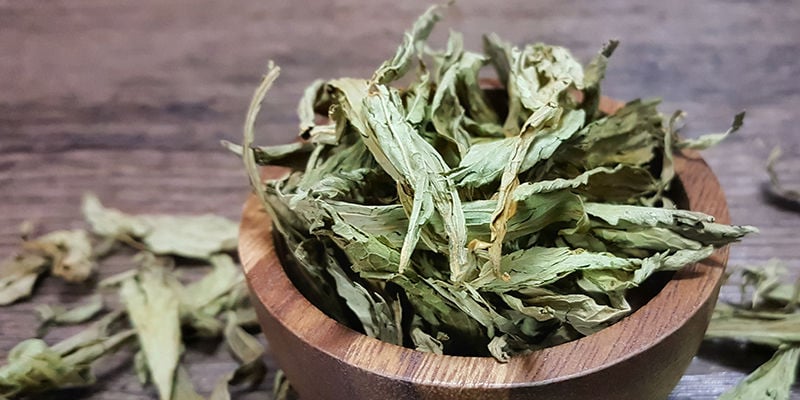
You can add fresh stevia leaves to tea or food, but they can also be dried and stored.
They dry very easily, especially in hot and dry weather. Simply lay them out on a tray or wire mesh, and they should air-dry within about 24 hours. Once they’re dry, they can be pulverised with a mortar and pestle, and the powder can be stored. This powder is a perfect ingredient for a variety of foods and drinks—let your appetite guide you.
Benefits of stevia
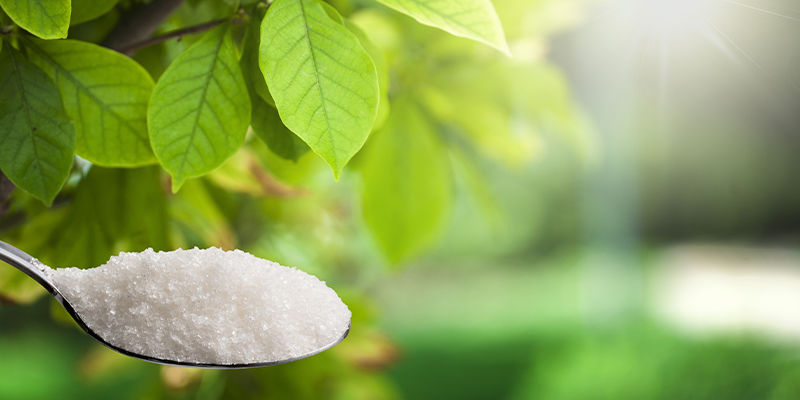
The major benefit of stevia is that it is a calorie-free sweetener. This can be useful if you want to avoid sugar and artificial sweeteners for all sorts of reasons, for example if you want to eat more healthily or if you have diabetes. A 2010 study found that stevia, in comparison to sugar, significantly lowered glucose and insulin levels in the blood (Anton, 2010).
If it's used only occasionally, stevia will not make a huge difference in this regard. However, if used on a daily basis, there is speculation that it could be beneficial.
Is stevia the ideal sugar substitute?
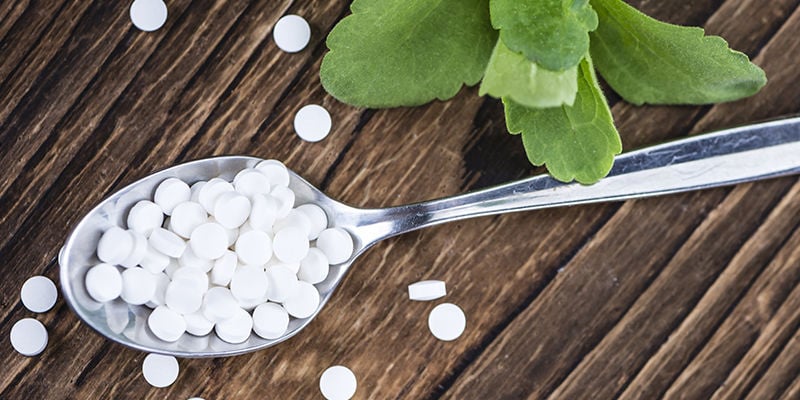
Stevia can be a great sugar substitute, but like most things in life, it’s not perfect. First, although it’s incredibly sweet, it doesn’t taste exactly like sugar. This means that using it as a direct substitute is unrealistic. However, for people who like the taste and are willing to adapt their drinks and dishes a little, it can work rather well.
While stevia may offer some results regarding glucose and insulin levels in the blood, there is some evidence to suggest that it may have some negative effects regarding beneficial gut flora (Nettleton, 2019). So people shouldn’t assume that switching over to stevia will only have positive effects. If you're looking to fully replace other sweeteners with stevia, consider doing some more research first.
Stevia: FAQ
- 🦷 Is stevia bad for your teeth?
- No, stevia is not thought to be bad for teeth.
- ⛑Is stevia healthy?
- Stevia is basically calorie-free, and is better for glucose and insulin levels compared to standard sugar. However, that is not to say that it is “healthy”, and it may have some adverse effects.
- ➗How much stevia can you take per day?
- There is little research regarding an appropriate daily dose of stevia.
- ✅Is stevia safe to consume?
- Yes, generally stevia is thought to be safe to consume. However, people should still be mindful of any potential changes.
Stevia: A worthy addition to your garden and diet
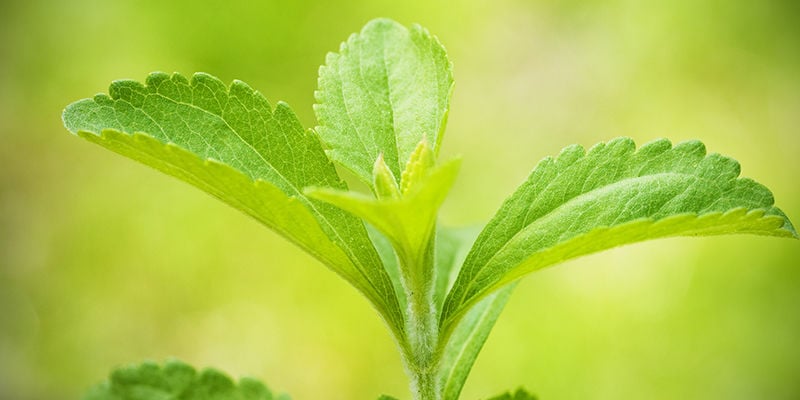
Offering an easy and rewarding growing experience, this natural sweetener is certainly worth adding to your garden or balcony. It’s a versatile plant that could benefit wellness while satisfying your appetite for sweet stuff. Why not give it a try this season?
- Anton, S. D., Martin, C. K., Han, H., Coulon, S., Cefalu, W. T., Geiselman, P., & Williamson, D. A. (2010/08/01). Effects of stevia, aspartame, and sucrose on food intake, satiety, and postprandial glucose and insulin levels - https://www.sciencedirect.com
- Nettleton, Jodi E., Klancic, Teja, Schick, Alana, Choo, Ashley C., Shearer, Jane, Borgland, Stephanie L., Chleilat, Faye, Mayengbam, Shyamchand, Reimer, & Raylene A. (2019/6). Low-Dose Stevia (Rebaudioside A) Consumption Perturbs Gut Microbiota and the Mesolimbic Dopamine Reward System - https://www.mdpi.com
-
 4 min
19 May 2023
Discover 10 Unique-Looking Vegetables
Do you want to sow some strange and novel fruits and vegetables in your garden this spring? Well, look no further—we’ve got you covered with this top 10 list of odd-looking plants to add some...
4 min
19 May 2023
Discover 10 Unique-Looking Vegetables
Do you want to sow some strange and novel fruits and vegetables in your garden this spring? Well, look no further—we’ve got you covered with this top 10 list of odd-looking plants to add some...
-
 4 min
28 April 2023
Top 10 Easy-To-Grow Herbs
Ever wanted to cultivate your very own herbs, but thought the task would be too demanding or that you wouldn't have enough space? Well, we're to say that these problems are a thing of the past!...
4 min
28 April 2023
Top 10 Easy-To-Grow Herbs
Ever wanted to cultivate your very own herbs, but thought the task would be too demanding or that you wouldn't have enough space? Well, we're to say that these problems are a thing of the past!...





 United States
United States











